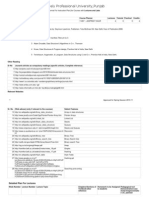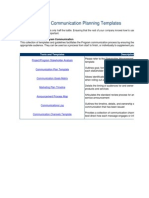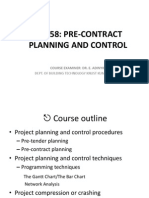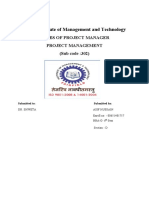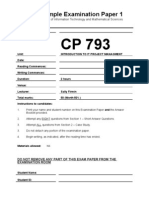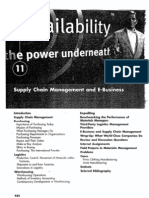CSE211
CSE211
Uploaded by
Mohammad YusufCopyright:
Available Formats
CSE211
CSE211
Uploaded by
Mohammad YusufCopyright
Available Formats
Share this document
Did you find this document useful?
Is this content inappropriate?
Copyright:
Available Formats
CSE211
CSE211
Uploaded by
Mohammad YusufCopyright:
Available Formats
CSE211:COMPUTER ORGANIZATION AND DESIGN
L:3 T:1 P:0 Credits:4
Course Outcomes: Through this course students should be able to
CO1 :: recognize the need and understanding of basic building blocks of digital circuits
CO2 :: discuss about the usability of various functional components of a digital computer
CO3 :: apply the knowledge of building blocks to get more insights about the working operations
of various functional components of digital system
CO4 :: categorize the different types of transfer schemes and analyze the process of direct
memory access
CO5 :: illustrate and getting more insights about the interconnection structure of memory
CO6 :: define pipelining and provide the technical insights about the latest trends of computer
architecture
Unit I
Basics Of Digital Electronics : registers, shift registers, Introduction to combinational circuit,
introduction to sequential circuits
Register Transfer and Micro Operations : Bus and Memory Transfer, Logic Micro Operations, Shift
Micro Operations, register transfer language, register transfer, arithmetic logic shift unit
Unit II
Computer Organization : instruction codes, computer registers, common bus system, computer
instructions, timing and control, instruction cycle, memory reference instructions, input-output and
interrupt
Unit III
Central Processing Unit : General Register Organization, Stack Organization, Addressing Modes,
Reduced instruction set computer, Complex instruction set computer, instruction formats
Unit IV
Input-Output Organization : Peripheral Devices, Input Output Interface, Data Transfer Schemes,
Program Control and Interrupts, Direct Memory Access Transfer and Input/Output Processor, Priority
interrupt, Direct memory access transfer, Input/Output processor., modes of data transfer, Processor
status word
Unit V
Memory Unit : Memory Hierarchy and Processor Vs Memory Speed, Associative Memory, Memory
Management, Memory hierarchy, Cache memory, Virtual memory, main memory, auxiliary memory
Unit VI
Computer Arithmetic : Addition and Subtraction Algorithm, Multiplication Algorithm
Introduction to Parallel Processing : Pipelining, Characteristics of multiprocessors,
Interconnection Structures, parallel processing
Latest technology and trends in computer architecture : next generation processors
architecture, microarchitecture, latest processor for smartphone or tablet and desktop
Text Books:
1. COMPUTER SYSTEM ARCHITECTURE by M. MORRIS MANO, RAJIB MALL, PEARSON
References:
1. COMPUTER ORGANIZATION AND ARCHITECTURE by WILLIAM STALLINGS, PEARSON
Session 2023-24 Page:1/2
Session 2023-24 Page:2/2
You might also like
- COMP3250 Assignment 1Document5 pagesCOMP3250 Assignment 1Anonymous 4qvaR8ZeNo ratings yet
- Routing Protocol AssignmentDocument17 pagesRouting Protocol AssignmentronicaNo ratings yet
- Pmi Rep HandbookDocument31 pagesPmi Rep HandbookNirupan KumarNo ratings yet
- Project Charter Group 3Document4 pagesProject Charter Group 3Abhinav VohraNo ratings yet
- IPM AssigmentDocument5 pagesIPM AssigmentVinod sagar50% (2)
- Ip Cse 205Document7 pagesIp Cse 205Gautam RajpalNo ratings yet
- Mth401:Discrete Mathematics: Course OutcomesDocument1 pageMth401:Discrete Mathematics: Course Outcomes21st TechNo ratings yet
- CSE320Document2 pagesCSE320Devansh YadavNo ratings yet
- An Opportunistic Routing ProtocolDocument3 pagesAn Opportunistic Routing ProtocoldbpublicationsNo ratings yet
- Answers For TMA 2 of ContemporaryDocument7 pagesAnswers For TMA 2 of Contemporarymichael100% (1)
- 1.1 General: Chabahil Road in Kathmandu District, BagmatiDocument25 pages1.1 General: Chabahil Road in Kathmandu District, Bagmatienlacer009No ratings yet
- Unit 9 Assignment 2 BriefDocument3 pagesUnit 9 Assignment 2 BriefHannahNo ratings yet
- Software Engneering Module 2 NotesDocument43 pagesSoftware Engneering Module 2 NotesJinu Regi100% (2)
- Linear Models: The Least-Squares Method, The Perceptron: A Heuristic Learning Algorithm ForDocument25 pagesLinear Models: The Least-Squares Method, The Perceptron: A Heuristic Learning Algorithm ForChrsan RamNo ratings yet
- MG6088-Software Project ManagementDocument12 pagesMG6088-Software Project ManagementAkn NanthanNo ratings yet
- Eng Peer Review Guidelines and ChecklistDocument2 pagesEng Peer Review Guidelines and ChecklistAshish RanjangaonkarNo ratings yet
- Unit - Iii: Project Monitoring and ControlDocument75 pagesUnit - Iii: Project Monitoring and ControlyekoyesewNo ratings yet
- Book Answer Summaries Chapter 2 3Document6 pagesBook Answer Summaries Chapter 2 3ghada alshabibNo ratings yet
- Braindump JK0-017Document87 pagesBraindump JK0-017cremer.rikeNo ratings yet
- Softwre Project ManagementDocument24 pagesSoftwre Project Managementkakoli19801980No ratings yet
- Abera AbebawDocument80 pagesAbera AbebawdagneNo ratings yet
- 140037-PM Unit 3Document18 pages140037-PM Unit 3selvalakshmiNo ratings yet
- AD 03. Requirements DeterminationDocument41 pagesAD 03. Requirements DeterminationAhmad SentanuNo ratings yet
- Chapter 1 Query ProcessingDocument45 pagesChapter 1 Query ProcessingWaal Mk100% (1)
- Rizal Technological University: Department of ArchitectureDocument5 pagesRizal Technological University: Department of ArchitectureMharcianeMaxineMagoNo ratings yet
- Project Communication Planning Templates: Process To Facilitate Program CommunicationDocument25 pagesProject Communication Planning Templates: Process To Facilitate Program Communicationpamoli01No ratings yet
- EdWel PMP Exam Preparation Course Ebook ExcerptDocument11 pagesEdWel PMP Exam Preparation Course Ebook ExcerptSPNo ratings yet
- Acclaim Series 10 Fire Extinguishing PanelDocument6 pagesAcclaim Series 10 Fire Extinguishing Panelnastyn-1No ratings yet
- PMBOK QUIZ 6 - Quality 2019Document8 pagesPMBOK QUIZ 6 - Quality 2019CarlosNo ratings yet
- Chapter 1 - SPMDocument21 pagesChapter 1 - SPMHEMANT THAKAR100% (1)
- CSG2344 Assignment 2 2017Document7 pagesCSG2344 Assignment 2 2017Berny PNo ratings yet
- Quality Plan Template - P1Document6 pagesQuality Plan Template - P1datbolNo ratings yet
- Project Communications ManagementDocument13 pagesProject Communications ManagementVikram KhemaniNo ratings yet
- Online Shopping ProjectDocument73 pagesOnline Shopping Projectdimple vermaNo ratings yet
- Software Project Management: Aamir Anwar Lecturer Computer Science SZABIST, IslamabadDocument25 pagesSoftware Project Management: Aamir Anwar Lecturer Computer Science SZABIST, IslamabadShams Illahi100% (1)
- Exploration of Software Engineering Lifecycle and Software Design of A Case Study CMP7243 Software Analysis and Design Student ID: Submission DateDocument16 pagesExploration of Software Engineering Lifecycle and Software Design of A Case Study CMP7243 Software Analysis and Design Student ID: Submission Datel145878No ratings yet
- Srs Lect 09Document41 pagesSrs Lect 09Muhammad HamzaNo ratings yet
- SQE Week 1 LectureDocument52 pagesSQE Week 1 LectureJavaria tanveer100% (1)
- Project Integration ManagementDocument26 pagesProject Integration ManagementNtuda DanielNo ratings yet
- Contract Planning NotesDocument108 pagesContract Planning NotesGodwin Acquah100% (1)
- B.Tech CSE III Yr. CN Lab SyllabusDocument1 pageB.Tech CSE III Yr. CN Lab Syllabusdeepanshu guptaNo ratings yet
- Chapter 4: Ensuring Your Requirements Are Correct: Requirement Validation TechniquesDocument2 pagesChapter 4: Ensuring Your Requirements Are Correct: Requirement Validation TechniquesEndris Mamo100% (1)
- CS615-FinalTerm MCQs With Reference Solved by ArslanDocument18 pagesCS615-FinalTerm MCQs With Reference Solved by Arslanziaur rehmanNo ratings yet
- Advanced JAVA ProgrammingDocument7 pagesAdvanced JAVA ProgrammingSaurabh TargeNo ratings yet
- A Project Management Information System Serves Five Principal PurposesDocument9 pagesA Project Management Information System Serves Five Principal PurposesSumme Ma TigeNo ratings yet
- Fairfield Institute of Management and Technology: Roles of Project Manager Project Management (Sub Code:302)Document11 pagesFairfield Institute of Management and Technology: Roles of Project Manager Project Management (Sub Code:302)chandni100% (1)
- Cost Management of Engineering ProjectsDocument2 pagesCost Management of Engineering ProjectsAadhilNo ratings yet
- Software EstimationDocument22 pagesSoftware Estimationcrazy ULTRON gamingNo ratings yet
- COMP 3511 - Operating SystemDocument38 pagesCOMP 3511 - Operating SystemLinh TaNo ratings yet
- Y2K38 PresentationDocument17 pagesY2K38 Presentationavatar_8085No ratings yet
- Poster On Real Time Face Recognition - Team RhetoriciansDocument1 pagePoster On Real Time Face Recognition - Team RhetoriciansAbdullah Al FahimNo ratings yet
- Smarter Work Management SystemDocument31 pagesSmarter Work Management SystemUsha Baburaj100% (1)
- Exam SampleDocument4 pagesExam Samplehiren_keepsmiling100% (1)
- Question One: Discussion of The Project Life Cycle: Conceptuali Ze Deliver & Close OutDocument4 pagesQuestion One: Discussion of The Project Life Cycle: Conceptuali Ze Deliver & Close OutMzee KodiaNo ratings yet
- Operations Management 1Document67 pagesOperations Management 1apoorvbabel0% (1)
- CSE316Document7 pagesCSE316anon_262108279No ratings yet
- OWP Primavera Professional PDFDocument4 pagesOWP Primavera Professional PDFShafiNo ratings yet
- Chapter 2 - SQA Components in The Project Life CycleDocument113 pagesChapter 2 - SQA Components in The Project Life CycleLộc TấnNo ratings yet
- CSE306Document36 pagesCSE306Mohammad YusufNo ratings yet
- SETADocument4 pagesSETAMohammad YusufNo ratings yet
- Set CDocument4 pagesSet CMohammad YusufNo ratings yet
- Set BDocument4 pagesSet BMohammad YusufNo ratings yet
- Set ADocument4 pagesSet AMohammad YusufNo ratings yet
- LectureZero - CSE320Document31 pagesLectureZero - CSE320Mohammad YusufNo ratings yet
- HologramDocument7 pagesHologramMohammad YusufNo ratings yet
- Ca2 Cse320Document35 pagesCa2 Cse320Mohammad YusufNo ratings yet
- Ca2 Mec135Document73 pagesCa2 Mec135Mohammad YusufNo ratings yet
- Ca2 Phy110Document6 pagesCa2 Phy110Mohammad YusufNo ratings yet






